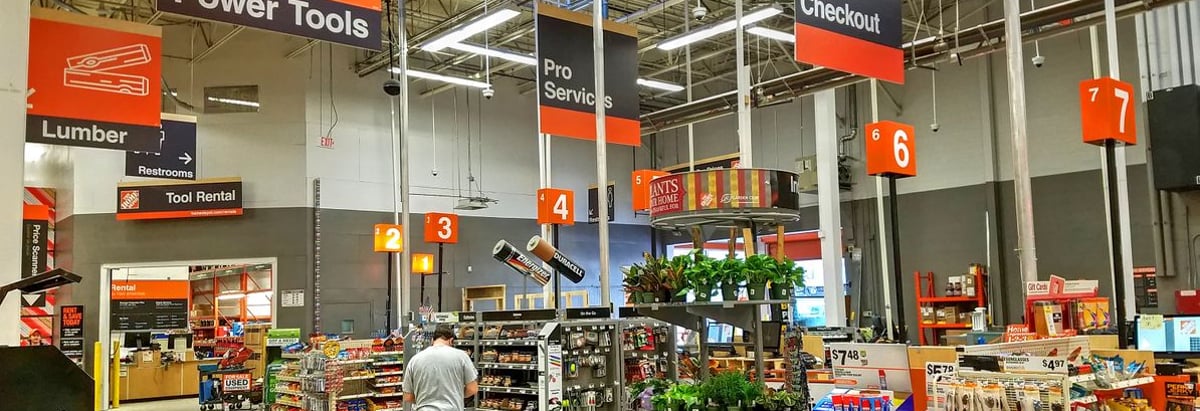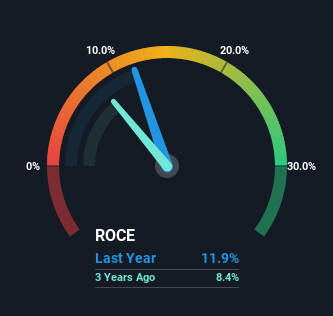
If you're looking for a multi-bagger, there's a few things to keep an eye out for. Ideally, a business will show two trends; firstly a growing return on capital employed (ROCE) and secondly, an increasing amount of capital employed. Basically this means that a company has profitable initiatives that it can continue to reinvest in, which is a trait of a compounding machine. That's why when we briefly looked at Kingfisher's (LON:KGF) ROCE trend, we were pretty happy with what we saw.
Return On Capital Employed (ROCE): What is it?
If you haven't worked with ROCE before, it measures the 'return' (pre-tax profit) a company generates from capital employed in its business. The formula for this calculation on Kingfisher is:
Return on Capital Employed = Earnings Before Interest and Tax (EBIT) ÷ (Total Assets - Current Liabilities)
0.12 = UK£1.1b ÷ (UK£12b - UK£3.1b) (Based on the trailing twelve months to January 2022).
Therefore, Kingfisher has an ROCE of 12%. In isolation, that's a pretty standard return but against the Specialty Retail industry average of 16%, it's not as good.
See our latest analysis for Kingfisher

Above you can see how the current ROCE for Kingfisher compares to its prior returns on capital, but there's only so much you can tell from the past. If you're interested, you can view the analysts predictions in our free report on analyst forecasts for the company.
What Does the ROCE Trend For Kingfisher Tell Us?
The trend of ROCE doesn't stand out much, but returns on a whole are decent. The company has employed 23% more capital in the last five years, and the returns on that capital have remained stable at 12%. Since 12% is a moderate ROCE though, it's good to see a business can continue to reinvest at these decent rates of return. Over long periods of time, returns like these might not be too exciting, but with consistency they can pay off in terms of share price returns.
Our Take On Kingfisher's ROCE
To sum it up, Kingfisher has simply been reinvesting capital steadily, at those decent rates of return. Despite the good fundamentals, total returns from the stock have been virtually flat over the last five years. That's why we think it'd be worthwhile to look further into this stock given the fundamentals are appealing.
Since virtually every company faces some risks, it's worth knowing what they are, and we've spotted 2 warning signs for Kingfisher (of which 1 is a bit unpleasant!) that you should know about.
For those who like to invest in solid companies, check out this free list of companies with solid balance sheets and high returns on equity.
Valuation is complex, but we're here to simplify it.
Discover if Kingfisher might be undervalued or overvalued with our detailed analysis, featuring fair value estimates, potential risks, dividends, insider trades, and its financial condition.
Access Free AnalysisHave feedback on this article? Concerned about the content? Get in touch with us directly. Alternatively, email editorial-team (at) simplywallst.com.
This article by Simply Wall St is general in nature. We provide commentary based on historical data and analyst forecasts only using an unbiased methodology and our articles are not intended to be financial advice. It does not constitute a recommendation to buy or sell any stock, and does not take account of your objectives, or your financial situation. We aim to bring you long-term focused analysis driven by fundamental data. Note that our analysis may not factor in the latest price-sensitive company announcements or qualitative material. Simply Wall St has no position in any stocks mentioned.
About LSE:KGF
Kingfisher
Supplies home improvement products and services primarily in the United Kingdom, Ireland, France, and internationally.
Flawless balance sheet with proven track record and pays a dividend.


